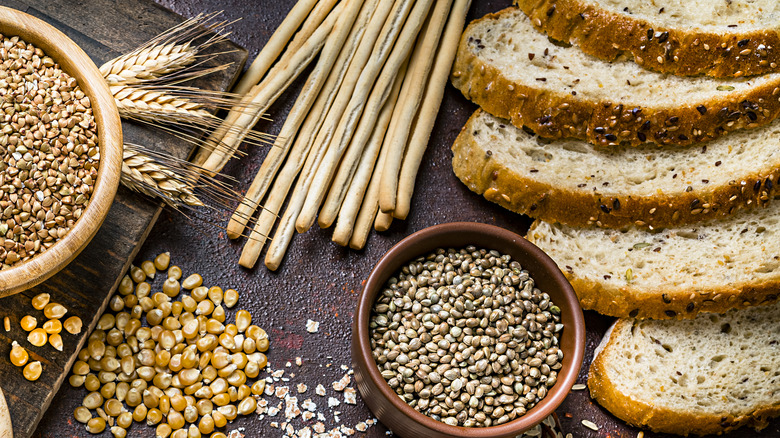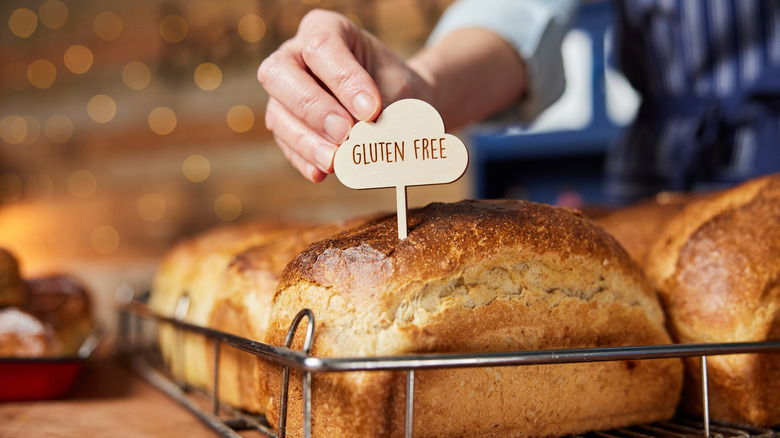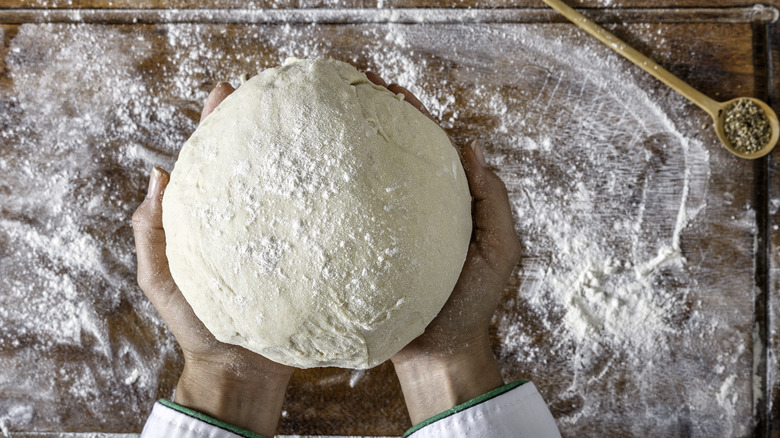Carbonated Water Is The Ultimate Cheat Code For Gluten-Free Bread
If you've ever tried your hand at making gluten-free bread, you might have noticed it can be a difficult bake. Gluten — the combination of glutenin and gliadin proteins — is a key ingredient in bread baking and can be found in many flours, including wheat, rye, and barley. When flour is mixed with water, it activates the gluten molecules and creates strands that interlock and trap air and gas bubbles formed by activated yeast. As more gluten develops — through mixing and proofing — the dough rises and takes on an airy texture. It also gives the loaf some elasticity and allows the bread to rise without cracking.
Without this gluten production, bread becomes much flatter, denser, more chewy, and more crumbly. So how do you make your bread rise if you can't add gluten? Try carbonated water to really elevate your loaf. The carbon dioxide from carbonated water will add some bubbles to your dough, creating much-needed structure, airiness, and lift in your bread.
Ingredients for a better gluten-free bread
A great loaf of gluten-free bread starts with an alternative flour like sorghum, buckwheat, white rice, almond, coconut, or amaranth flour. These gluten-free flours can be utilized for different types of baking — cookies, cakes, pie crusts, etc. — so be sure to follow your recipe closely for the best results.
Another helpful tip is to make sure your ingredients are at room temperature before beginning. Gluten-free flour is often kept in the refrigerator or freezer to keep it fresh, but the cold stunts the growth of yeast, so measure out these ingredients and leave them out overnight. For wet ingredients like eggs, butter, and milk, leave them on the counter for about an hour before you start mixing your dough.
If your recipe calls for butter, try whipping the butter before adding it as this will further increase the lift in your dough. Most gluten-free bread will also call for yeast and eggs, both of which will help the dough to rise, but it still might not have the right airiness to it. To nail the texture, substitute any water in the recipe for carbonated water, allowing for a lighter, bubbly batter. You can also try a gluten-free beer to give your bread a little extra flavor.
The process of making gluten-free bread
The traditional methods of bread making revolve almost entirely around the production of gluten, so if you're baking a gluten-free bread, it's a bit more involved than just swapping the ingredients for gluten-free ones.
Wheat loaves get tough when you knead the dough too much, but that's not a concern with gluten-free loaves, so feel free to save your energy and use a standup mixer to knead your dough as much as you like.
Gluten-free bread loaves are naturally smaller and heavier when compared to regular wheat loaves. Because gluten-free dough doesn't rise like traditional bread dough, the loaf becomes far more dry and dense. Additionally, it lacks the sponge-like structure we've come to know in bread. If your gluten-free bread isn't the right texture, try toasting it to level out the crispiness in each slice.
Be wary when it comes to storing your gluten-free bread as they don't stay fresh as long as wheat loaves. In general, the more moist a baked good is, the longer it will keep. Since gluten-free bread tends to be on the drier side, make sure you eat your loaf quickly to keep it from going bad. You can also try putting any leftovers in the refrigerator to last a few extra days or freeze your loaf to last up to two months.



